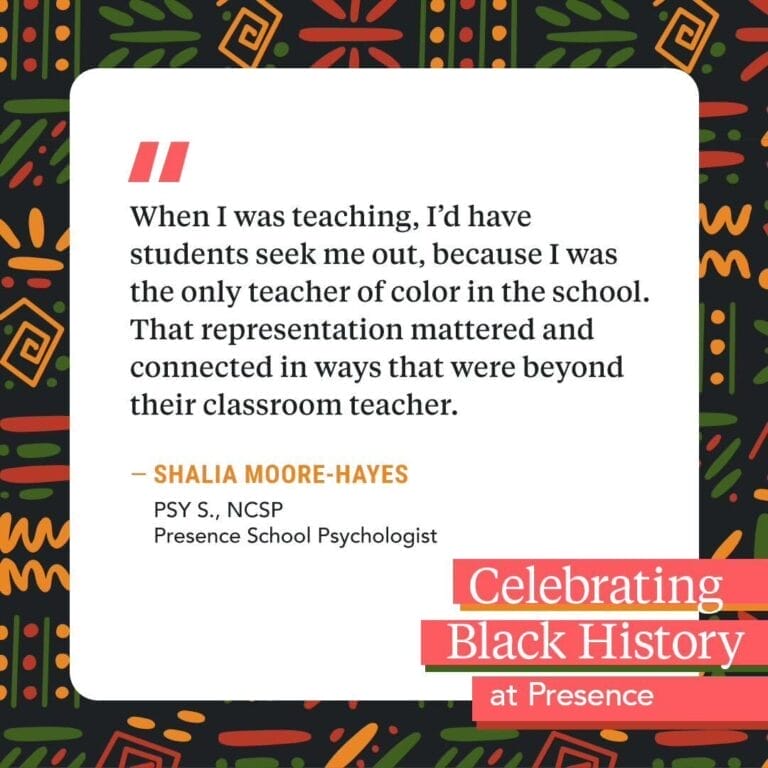
If you’ve ever felt like an outsider, you might better understand representation. Imagine walking into a classroom and everyone’s wearing blue but you were dressed in red from head to toe. Would you feel more included if the teacher was also wearing red?
Approximately 86 percent of psychologists and therapists are white. Studies show people of color lack therapists who look like they do and share similar cultural experiences. For teens and young adults of color, it can often feel like a burden to explain problems and experiences to white therapists* (source). If students need support, they may seek it from someone more similar, as Presence school psychologist, Shalia Moore-Hayes Psy S., NCSP, experienced.
When I was teaching, I’d have students seek me out, because I was the only teacher of color in the school. That representation mattered and connected in ways that were beyond their classroom teacher.
Anecdotally, it’s easy to understand how others who look similar or may have common backgrounds can make someone feel more included. To better understand the importance of representation in a therapeutic setting, we asked Presence experts to share their experiences.

Why representation is so important
How minorities are portrayed or represented in society affects how students perceive individuals of color and how minority students perceive themselves. So, if all students wearing blue were portrayed as smart, students wearing red may not feel as smart. In the therapeutic setting, representation begins with things like books and therapeutic activities, and it extends to the therapist.
Representation can have profound effects.“If children don’t have role models, they can’t imagine beyond what they see,” said Presence clinician, Vicki Turner, DM, MA, CCC-SLP. For example, seeing Black physicists, thought leaders, or therapists inspires kids to follow in their in footsteps.
“When we normalize seeing Black professionals in spaces, that’s how you see change. It’s important to see and interact with professionals of color because it creates positive experiences that counter negative stereotypes found in media and culture.
”
It also builds tolerance and open mindedness. When students have exposure to more diversity, they realize “our world is a beautiful and unique place when we have people from all different backgrounds,” added Moore-Hayes.
Clinician-student rapport develops more quickly, too. “It can strengthen the relationship and give a starting point to better relate in therapy,” said Presence Clinical Quality and Resource Manager, Erika Ayanaw, Ed.S., Ph.D., NCSP.

Five ways to better representation
As ongoing research examines representation and its positive effect on clinical outcomes, consider these five ways to include more representation in your sessions today.
- Honor Diversity All Year Long
While national designations like Martin Luther King Day, Indigenous Peoples Day, or Black History Month help increase awareness, representation should happen year-round. It can be a “positive experience anytime versus a mandated one during set holidays,” said Holmes. “Black History is American History, it doesn’t need to be taught only in February,” urges Turner. Need some ideas? Consider helping your students practice reading with the “ABCs of Black History” or reading works by great American poets, including Phyllis Wheatley. - Celebrate Individuality
Not every person of color is the same. It’s important to “look beyond academics in the classroom, and see each student as an individual,” said Moore-Hayes. For example, make sure assessments are culturally sensitive. Assessments can be text-heavy and include reading levels many students are not exposed to or understand. She recommends finding bilingual specialists or trying nonverbal assessments to avoid language barriers and misdiagnoses. “Do more digging and look at all the pieces of the puzzle,” said Moore-Hayes. - Meet Therapy Goals, Creatively
Representation can be part of everyday activities, therapeutically sound, and fun. Including role models can be a great way of normalizing representation and keeping on target with therapy goals. Presence therapist, Tasha Holmes, created teletherapy activities on Black people in history. “Students could listen to or read a story on Dr. Mae Jemison and then do a yoga pose to answer test questions as true or false.” Holmes also created a cryptogram for boosting handwriting and visual skills. She’d then have students solve the cryptogram to find out what languages the famous Black astronaut learned. - Broaden Your Representation
Stereotypes can be unintentionally taught through the ways minorities are portrayed. Avoid this by using diverse representations of people of color. Include more than sports icons, for example. Consider additional scientists, educators, and poets. “There are so many who have done amazing things. Read about Amanda Gorman, not just the same five people we always learn about in history,” added Holmes. - Acknowledge Your Role
As the specialist, teacher, or parent, you are an expert and what you represent in and out of the sessions matters. “Do not assume you know, but gain knowledge and cultural humility with whom you are working,” advised Turner. “Also be connected with who you are, “ said Moore-Hayes. Be comfortable with who you are and “what you bring to the table.”

Representation moves us all one step closer to a more diverse and accepting world. Together we can build connections and ensure all ethnicities, nationalities, and lifestyles are respected, highlighted, and celebrated.




